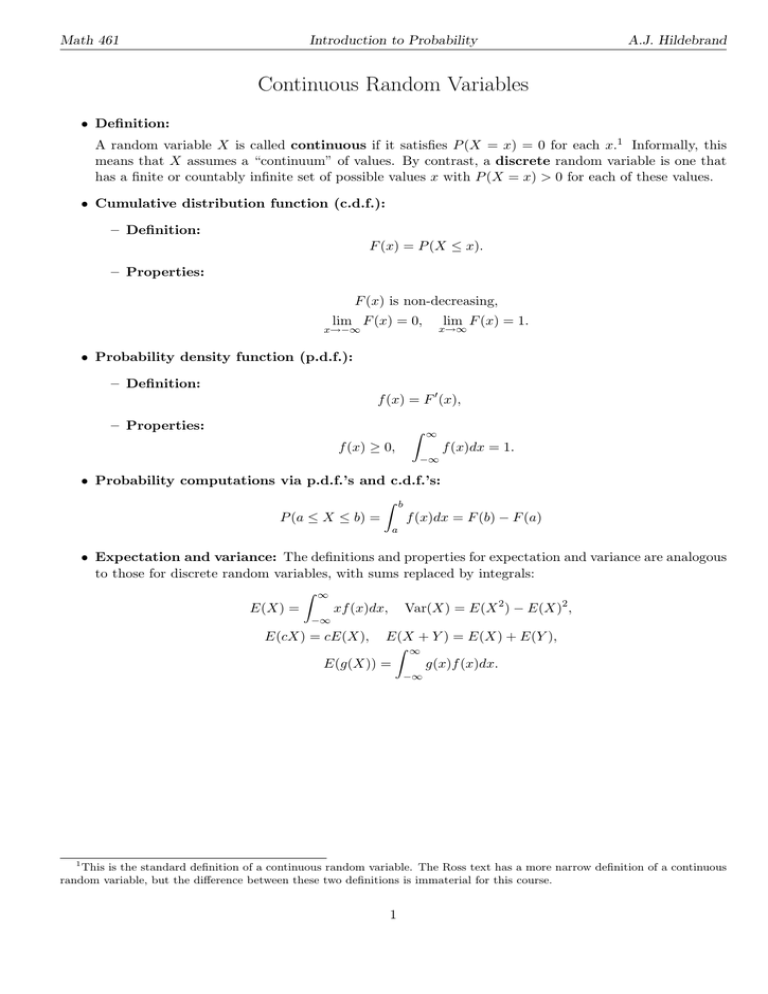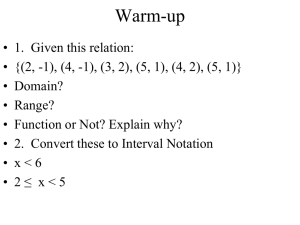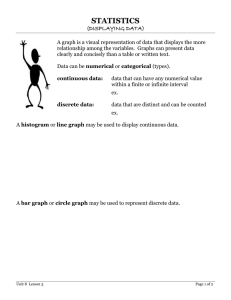Continuous Random Variables
advertisement

Math 461 Introduction to Probability A.J. Hildebrand Continuous Random Variables • Definition: A random variable X is called continuous if it satisfies P (X = x) = 0 for each x.1 Informally, this means that X assumes a “continuum” of values. By contrast, a discrete random variable is one that has a finite or countably infinite set of possible values x with P (X = x) > 0 for each of these values. • Cumulative distribution function (c.d.f.): – Definition: F (x) = P (X ≤ x). – Properties: F (x) is non-decreasing, lim F (x) = 0, lim F (x) = 1. x→∞ x→−∞ • Probability density function (p.d.f.): – Definition: f (x) = F 0 (x), – Properties: Z ∞ f (x) ≥ 0, f (x)dx = 1. −∞ • Probability computations via p.d.f.’s and c.d.f.’s: Z P (a ≤ X ≤ b) = b f (x)dx = F (b) − F (a) a • Expectation and variance: The definitions and properties for expectation and variance are analogous to those for discrete random variables, with sums replaced by integrals: Z ∞ E(X) = xf (x)dx, Var(X) = E(X 2 ) − E(X)2 , −∞ E(cX) = cE(X), E(X + Y ) = E(X) + E(Y ), Z ∞ E(g(X)) = g(x)f (x)dx. −∞ 1 This is the standard definition of a continuous random variable. The Ross text has a more narrow definition of a continuous random variable, but the difference between these two definitions is immaterial for this course. 1 Math 461 Introduction to Probability A.J. Hildebrand • Notes and tips: – Note that, although a p.d.f. f (x) of a continuous r.v. plays the same role as a p.m.f. p(x) of a discrete r.v., the definitions of these two functions are completely different: In the discrete case, p(x) is defined as p(x) = P (X = x). In the continuous case, the probabilities P (X = x) are 0, so the same definition would not make sense; in fact, f (x) can only be obtained indirectly as the derivative of the c.d.f. F (x). Another difference between the functions f (x) and p(x) is that a p.d.f. f (x) can take values larger than 1, while a p.m.f. p(x) always satisfies 0 ≤ p(x) ≤ 1. – Keep track of the “range” of a density: Most random variables have a finite, or one-sided infinite, range (i.e., set of values), such as the interval [0, 1], or [1, ∞). Outside this range the density function f (x) is 0. It is important to keep this range in mind when trying to determine the correct integration limits. For example, if a problem asks for P (X ≥ 2) and the density f (x) “lives” on the interval [1, 4], the integral giving P (X ≥ 2) should be from 2 to 4; if, instead, f (x) were defined and non-zero on the infinite interval [1, ∞), the integral would be from 2 to infinity. To prevent mistakes, make it a habit to always write down the “range” of a density f (x) along with the formula. i.e., the interval of x on which the function is defined and non-zero). – For probabilities involving continuous random variables, “≤” and “<”, and similarly “≥” and “>”, are interchangeable: For example, P (X ≤ 2) is the same as P (X < 2), since the difference between these two probabilities, P (X = 2), is 0 for a continuous random variable. By the same token, when specifying the range of a density functions, it doesn’t matter whether or not one includes the boundary points in the range. For example, in the definition “f (x) = 2x for 0 < x < 1” one could replace the range “0 < x < 1” by “0 ≤ x ≤ 1” without affecting any probability calculations involving this density. 2







